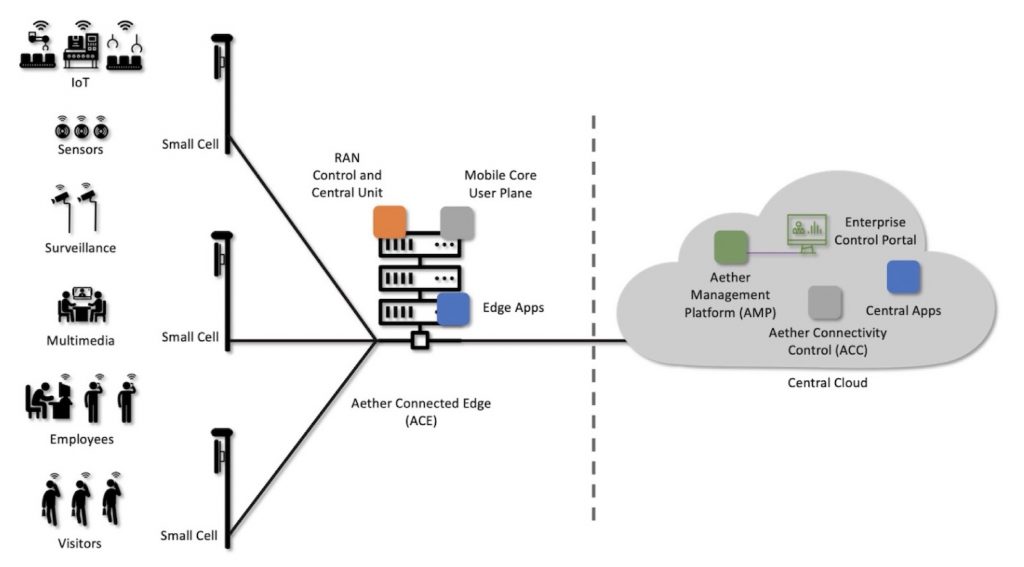In collaboration with Open Networking Foundation, Gigabyte Technology and MSI
Introduction
The enterprise edge services market is expected to feature many greenfield applications and opportunities, with fast compound annual growth rate. 5G, SDN, disaggregation, virtualization and cloudification are essential technologies for enabling state-of-the-art 5G connected edge platforms and deploying a wide range of enterprise edge services. Open Networking Foundation (ONF)1 established the Aether community in November 2019 to focus on architecting and piloting deployment of an enterprise 5G connected edge platform called Aether. At this point, ONF has deployed Aether successfully in multiple sites around the world for research, academia and commercial uses3. AMD, an ONF member, has collaborated with ONF, Gigabyte Technology5 and MSI7 to deploy multiple pods of AMD EPYCTM processor based standard COTS servers for powering Aether demos and development.
Aether spans from on-premise locations and far-edge, to edge cloud(s), and central cloud. Figure 1 provides an overview. At enterprises or far-edge locations, small cells which utilize the CBRS or other authorized spectrum provide 5G/LTE wireless connectivity to cellular users and various connected devices. These small cells connect to an Aether edge platform which resides in an edge datacenter or telco central office. The Aether edge platform runs on one or more pods of standard COTS servers. The Aether edge platform hosts multiple wireless infrastructure network functions and edge services which are deployed in individual containers and/or virtual machines. The wireless infrastructure network functions include 5G/LTE RAN control and 5G UPF (User Plane Function of 5G mobile core). Aether edge platforms are centrally managed by Aether Management Platform and Aether Connectivity Control which reside in a central cloud.

Figure 1: Aether providing Enterprise-5G/LTE-Edge-Cloud-as-a-Service2
Key Enabling Technologies
5G, SDN, disaggregation, virtualization/containerization and cloudification all represent break-through technology advancements and major industry trends. All of these technologies play an essential role in implementing a state-of-the-art 5G/LTE connected edge platform.
5G provides major improvement in latencies, throughput, cost effective massive IoT connectivity and mobility. Combinations of these improvements enable a wide range of enterprise services and user experience. For example, cost effective massive IoT connectivity plus machine learning inferencing and analytics on video, pictures and other data enables edge services like security surveillance, business intelligence like store traffic patterns, smart city, public safety, etc. The latency improvement to sub 10ms or better plus the built-in security and reliable connectivity of 5G cellular technology enables highly responsive control of robotics and machines for manufacturing automation. These are just two examples of greenfield and game-changing enterprise services.
SDN (Software Defined Networking) enables flexibility and automation in managing and dynamically optimizing the switching fabric. The Aether switching fabric is implemented with P4-programmable switches in leaf-spine topology. The switch fabric can provide in-band telemetry and implement network functions like UPF (mobile core user plane function).
Disaggregation separates hardwired purpose-built networking equipment into interoperable virtualized or containerized network functions with standardized interfaces and deployable on standard COTS hardware. As a result, disaggregation significantly improves agility, operational efficiency, TCO and eco-systems. In this 5G/LTE connected edge platform scenario, the 5G/LTE RAN (Radio Access Network) may be disaggregated into RU (Radio Unit), DU (Distributed Unit) and CU (Centralized Unit), as specified by O-RAN Alliance. Moreover, the mobile core network is disaggregated so that the user plane (or data plane) processing for locally serviced cellular traffic is performed by UPF (user plane function) on the edge platform, i.e. Aether Connected Edge, as opposed to the mobile core at the central cloud. As a result of terminating the cellular protocols and deploying services at the edge, latency and quality of user experience improve drastically.
Virtualization and containerization improve utilization of the hardware infrastructure and automated orchestration of various edge services and network functions dynamically. The Aether project utilizes Kubernetes to deploy connectivity services as well as third-party enterprise services and applications onto the server pods in an edge datacenter.
Cloudification conveys the practice of deploying applications and services in datacenters which provide compute, networking and storage resources with automation and excellent efficiency. Aether implementations involve a central cloud where control and management functions are centralized for operational efficiency, and multiple edge clouds where disaggregated RAN and UPF, as well as enterprise edge services are deployed close to the users for excellent latencies and quality of user experience.
O-RAN Alliance4 Innovation
O-RAN Alliance’s mission is to transform the Radio Access Network industry towards truly open, intelligent, virtualized and fully interoperable RAN.
Two examples of innovation from O-RAN Alliance are RAN disaggregation and RIC (RAN Intelligent Controller).
By disaggregating the RAN into multiple interoperable components with standardized interfaces, O-RAN drives towards an open, virtualized and interoperable RAN and eco-system. Aether adopts disaggregation by utilizing small cells with centralized CU (Centralized Unit) running on the edge platform, instead of being part of the small cells.
O-RAN has introduced RIC into the O-RAN architecture. RIC enables software defined control and optimization of RAN functions. There are near-real-time RIC and non-real-time RIC. The near-real-time RIC typical resides in an edge platform, and it performs control and optimization functions which take between 10ms to 1s to complete. Moreover, the near-real-time RIC enforces policy guidance provided by the non-real-time RIC and provides feedback to the non-real-time-RIC. The near-real-time RIC operates by performing specialized applications called xApps. The non-real-time RIC performs control and optimization by running rApps, and it typically takes >1s to complete these actions. The Aether edge platform implements near-real-time RIC for software defined RAN control and optimization.
COTS server pods with AMD EPYC processors8.9
In collaboration with ONF, Gigabyte Technology5,6 and MSI7, we have added two pods of AMD EPYC processor based COTS servers into ONF’s demo and development pods. These pods are already active. Supporting standard x86 architecture, the additional AMD EPYC x86 processors based pods work seamlessly in ONF’s Aether 5G connected edge platform deployment.
Conclusions
Enterprise 5G edge services represent major greenfield market opportunities. State-of-the=art implementations depend on break-through technologies including 5G, SDN, disaggregation, virtualization and cloudification. ONF has architected and deployed an intelligent 5G connected edge platform. In collaboration with ONF, Gigabyte Technology and MSI, AMD has added EPYC processor based COTS server pods to ONF’s demo and development infrastructure seamlessly.
References:
- 1. ONF: https://opennetworking.org/
- 2. ONF Aether technical white paper: https://opennetworking.org/wp-content/uploads/2021/08/Aether-Technical-White-Paper-1.pdf
- 3. ONF’s Aether 5G Open Source Platform Selected by Kajeet to Build an Enterprise Private 5G Network Offering: https://opennetworking.org/news-and-events/press-releases/onfs-aether-private-5g-open-source-platform-selected-by-kajeet-to-build-a-enterprise-private-5g-network-offering/
- 4. O-RAN Alliance: https://www.o-ran.org/
- 5. Gigabyte Technology: https://www.gigabyte.com/Enterprise/x86-Server?fid=2359
- 6. Gigabyte AMD based pod: https://www.gigabyte.com/Enterprise/Edge-Server/H242-Z11-rev-100
- 7. MSI: https://www.msi.com/Landing/EPS-AMD
- 8. AMD EPYC processors: https://www.amd.com/en/processors/epyc-server-cpu-family
- 9. AMD Embedded processors: https://www.amd.com/en/products/embedded

